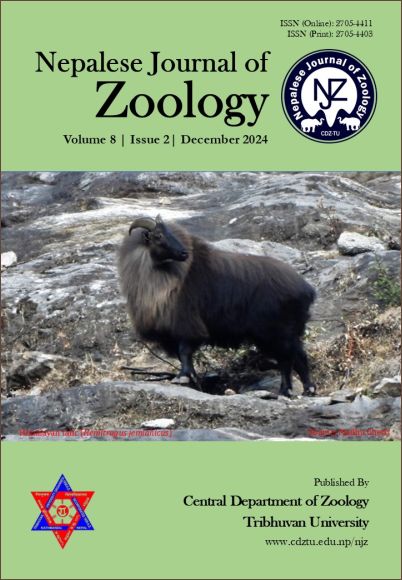Wildlife-vehicular traffic collisions in the Ooty–Masinagudi–Moyar roads at Western Ghats Mudumalai Tiger Reserve, Southern India
DOI:
https://doi.org/10.3126/njz.v8i2.74921Keywords:
forest roads, animal feeding, roadkill, tourism, vehicle movementsAbstract
In a world increasingly fragmented by human infrastructure, it is becoming increasingly important to understand the drivers of collisions between wildlife and motor vehicles. We studied wildlife-vehicle traffic collisions in the Ooty—Masinagudi—Moyar roads at Mudumalai Tiger Reserve, southern India, and recorded 111 road kills between January and June 2024, that affected 29 species of invertebrates, reptiles, birds, and mammals. Birds were the most susceptible taxa (41.6%), followed by reptiles (24.9%), mammals (23.1%) including a golden jackal (Canis aureus), two spotted deer (Axix axis), two tufted grey langur (Semnopithecus priam), and invertebrates (9.5%) (ANOVA: F=0.057, df=5.965, p=0.819). The encounter rate of elephants was 1.4/km between the Sigur-Masinagudi road and 1.1/km between the Masinagudi-Moyar road and all opportunistic direct sightings were positively correlated with speed bumps in place (F=8.464, d.f. =2.545, p=0.074). The study found that birds and reptiles were slow to react to quick vehicle movements, and hypothetically drivers' inexperience in forest roads likely led to higher mortality among these species. The Masinagudi-Moyar road experienced higher collisions due to tourist safari vehicles, drivers’ over-exhilaration, and wild animal feeding. To reduce wildlife road kills, we suggest regulating vehicle movements, implementing strict speed limits, controlling feeding, heightening speed bumps, and installing warning signboards along the roadside —this will help maintain a safer environment for wildlife movements.
Downloads
Downloads
Published
How to Cite
Issue
Section
License
Copyright (c) 2024 The Author(s)

This work is licensed under a Creative Commons Attribution-NonCommercial 4.0 International License.
This license enables reusers to distribute, remix, adapt, and build upon the material in any medium or format for noncommercial purposes only, and only so long as attribution is given to the creator.

